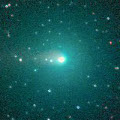
|
Now it is bright as 6.9 mag (Aug. 2, Marco Goiato). In the Northern Hemisphere, it will be observable in excellent condition after this. In the Southern Hemisphere, it keeps unobservable until early September.
Date(TT) R.A. (2000) Decl. Delta r Elong. m1 Best Time(A, h)
Aug. 2 5 0.71 37 52.1 1.023 0.911 53 6.3 5:27 (213, 7)
Aug. 9 4 35.39 45 7.7 0.855 1.007 64 6.4 5:21 (202, 5)
|

|
Now it is bright as 7.9 mag (July 3, Marek Biely). The brightening is somewhat slow, but it will brighten up to 6-7 mag in autumn. It is not observable from mid July to mid September.
Date(TT) R.A. (2000) Decl. Delta r Elong. m1 Best Time(A, h)
Aug. 2 9 22.39 18 12.4 2.133 1.138 8 7.6 18:45 (104,-11)
Aug. 9 9 18.22 15 47.5 2.113 1.100 0 7.5 18:49 ( 97,-17)
|
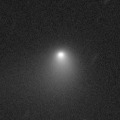
|
Now it is bright as 10.6 mag (Aug. 2, Marco Goiato). The brightening is somewhat slow, but it is expected to brighten up to 8.5 mag and to be observable in excellent condition from summer to autumn in the Southern Hemisphere. It keeps observable for a long time until early November in the Southern Hemisphere. In the Northern Hemisphere, it appears in the extremely low sky from late July to early August. But then it keeps unobservable until October. It will pass extremely close to Mars on Oct. 19.
Date(TT) R.A. (2000) Decl. Delta r Elong. m1 Best Time(A, h)
Aug. 2 3 19.63 -40 15.0 1.439 1.840 95 10.0 5:27 (295, 75)
Aug. 9 3 11.95 -46 8.8 1.268 1.779 101 9.6 5:21 (327, 76)
|
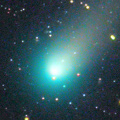
|
It brightened rapidly in outburst in mid October in 2013. Now it is bright as 9.8 mag (Aug. 2, Marco Goiato). It will be fading gradually after this. In the Southern Hemisphere, it keeps observable in good condition for a long time until the comet fades out. In the Northern Hemisphere, it keeps extremely low after this.
Date(TT) R.A. (2000) Decl. Delta r Elong. m1 Best Time(A, h)
Aug. 2 22 19.54 -44 49.9 1.704 2.614 146 9.9 1:39 ( 0, 80)
Aug. 9 22 12.98 -46 53.2 1.772 2.679 146 10.1 1:05 ( 0, 78)
|
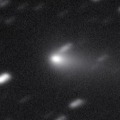
|
Appearing in the morning sky again. Now it is so bright as 10.2 mag (Aug. 2, Marco Goiato). It is expected to brighten up to 5 mag in autumn. In the Southern Hemisphere, it keeps observable until mid October including the highlight. In the Northern Hemisphere, it keeps observable in the morning low sky until early September when it brightens up to 6 mag.
Date(TT) R.A. (2000) Decl. Delta r Elong. m1 Best Time(A, h)
Aug. 2 6 0.45 12 3.3 1.884 1.296 40 11.0 5:27 (241, 18)
Aug. 9 6 9.34 10 27.1 1.659 1.189 45 10.3 5:21 (240, 21)
|

|
Brightening very rapidly. Now it is 13.7 mag (July 29, Katsumi Yoshimoto). It is expected to reach up to 10 mag in August. But actually, it is fainter than expected by 2 mag. It keeps observable in the morning sky until mid August while the comet will be brightening. The condition is good in the Southern Hemisphere. But it keeps extremely low in the Northern Hemisphere.
Date(TT) R.A. (2000) Decl. Delta r Elong. m1 Best Time(A, h)
Aug. 2 6 27.71 18 21.1 1.129 0.622 33 11.2 5:27 (240, 9)
Aug. 9 7 20.42 18 59.7 1.212 0.560 27 10.6 5:21 (245, 3)
|
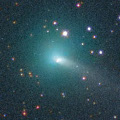
|
It brightened very rapidly, and brightened up to 9.4 mag in early July (July 4, Maik Meyer). However, it will be fading rapidly after this. It has already faded down to 11.5 mag (July 25, Jakub Cerny). It is observable in excellent condition in the Northern Hemisphere. In the Southern Hemisphere, it is not observable temporarily in mid July, but it is observable before and after mid July.
Date(TT) R.A. (2000) Decl. Delta r Elong. m1 Best Time(A, h)
Aug. 2 14 12.74 26 18.7 0.905 1.167 74 11.6 18:45 (161, 26)
Aug. 9 14 4.60 22 4.4 1.142 1.214 68 12.3 18:49 (150, 27)
|
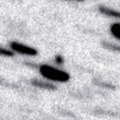
|
Appearing in the morning sky again. Now it is 14.4 mag (July 1, Jean-Francois Soulier). It keeps observable for a long time after this while the comet will be fading gradually.
Date(TT) R.A. (2000) Decl. Delta r Elong. m1 Best Time(A, h)
Aug. 2 6 31.09 17 45.2 2.546 1.775 32 12.8 5:27 (241, 8)
Aug. 9 6 49.29 17 10.3 2.539 1.801 34 12.9 5:21 (241, 9)
|

|
Now it is 13.4 mag (July 15, Yasukazu Ikari). It keeps bright as 13-14 mag for a long time from 2013 to 2014.
Date(TT) R.A. (2000) Decl. Delta r Elong. m1 Best Time(A, h)
Aug. 2 20 48.78 -30 13.7 2.121 3.120 167 13.5 0:09 (180, 85)
Aug. 9 20 43.76 -30 33.5 2.141 3.127 163 13.6 23:32 (180, 86)
|

|
Now it is 12.0 mag (June 25, Taras Prystavski).
Date(TT) R.A. (2000) Decl. Delta r Elong. m1 Best Time(A, h)
Aug. 2 15 19.54 -27 54.9 5.779 6.122 105 13.7 18:45 (164, 83)
Aug. 9 15 20.78 -27 47.0 5.884 6.120 98 13.7 18:49 (128, 79)
|
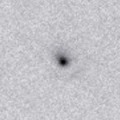
|
Appearing in the morning sky. In the Northern Hemisphere, it will be observable at 12-13 mag in excellent condition from 2014 summer to 2015 spring. In the Southern Hemisphere, it will locate low around the highlight.
Date(TT) R.A. (2000) Decl. Delta r Elong. m1 Best Time(A, h)
Aug. 2 6 21.04 26 0.6 2.869 2.117 34 14.0 5:27 (234, 5)
Aug. 9 6 38.77 26 9.9 2.808 2.097 37 13.9 5:21 (233, 5)
|
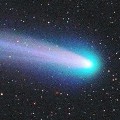
|
It passed only 0.4 A.U. from the earth, and 0.8 A.U. from the sun in November and December in 2013, and brightened up to 4.7 mag (Nov. 28, Juan Jose Gonzalez). Now it is 15.3 mag (July 1, Yasukazu Ikari). It keeps observable until autumn when the comet fades out.
Date(TT) R.A. (2000) Decl. Delta r Elong. m1 Best Time(A, h)
Aug. 2 15 33.74 -28 36.7 2.947 3.405 108 14.0 18:50 (180, 84)
Aug. 9 15 34.10 -29 2.5 3.132 3.485 101 14.2 18:49 (135, 82)
|

|
Now it is 13.4 mag (July 29, Marco Goiato). It keeps bright at 13-14 mag for a long time until 2014.
Date(TT) R.A. (2000) Decl. Delta r Elong. m1 Best Time(A, h)
Aug. 2 18 46.60 -2 17.9 5.784 6.654 146 14.2 22:02 (180, 57)
Aug. 9 18 41.51 -3 7.3 5.866 6.677 140 14.2 21:30 (180, 58)
|
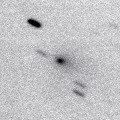
|
It brightened up to 2 mag by unusual major outburst in 2007. It is coming back now. Now it is bright as 13.2 mag (July 24, Jakub Cerny). In the Northern Hemisphere, it keeps observable until it fades out in 2015. In the Southern Hemisphere, it keeps extremely low after this.
Date(TT) R.A. (2000) Decl. Delta r Elong. m1 Best Time(A, h)
Aug. 2 3 48.83 37 7.3 2.470 2.280 67 14.5 5:27 (201, 14)
Aug. 9 4 1.46 38 25.0 2.422 2.302 71 14.6 5:21 (198, 14)
|
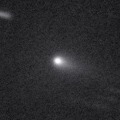
|
New bright comet. Now it is 14.7 mag (July 26, Jakub Cerny). It is observable at 14 mag in excellent condition until November.
Date(TT) R.A. (2000) Decl. Delta r Elong. m1 Best Time(A, h)
Aug. 2 23 58.19 -1 37.9 1.443 2.239 130 14.5 3:17 (180, 57)
Aug. 9 0 0.72 -1 49.0 1.397 2.245 136 14.5 2:52 (180, 57)
|
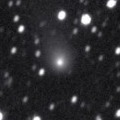
|
Now it is bright as 13.7 mag (July 23, Jakub Cerny). It keeps 13-14 mag and observable in good condition in the Northern Hemisphere for a long time from 2013 to 2014. In the Southern Hemisphere, it is not observable until 2014 autumn.
Date(TT) R.A. (2000) Decl. Delta r Elong. m1 Best Time(A, h)
Aug. 2 0 54.22 53 33.9 3.834 3.987 91 14.6 4:14 (180, 1)
Aug. 9 0 44.68 53 22.3 3.762 4.019 97 14.6 3:37 (180, 2)
|

|
It brightened up to 11-12 mag in 2012. Now it is 14.3 mag (June 25, Taras Prystavski). It is not observable now in the Northern Hemisphere. It will be unobservable in August also in the Southern Hemisphere. It will be observable at 15 mag in good condition again in 2015.
Date(TT) R.A. (2000) Decl. Delta r Elong. m1 Best Time(A, h)
Aug. 2 11 49.59 -6 34.3 8.556 7.959 51 14.8 18:45 (106, 32)
Aug. 9 11 50.51 -6 39.8 8.682 7.995 44 14.8 18:49 (101, 26)
|
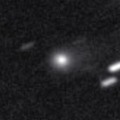
|
Now it is 14.7 mag (June 25, Taras Prystavski). It is expected to brighten up to 13 mag and to be observable in good condition in 2015. In 2014, it keeps observable in good condition from winter to summer.
Date(TT) R.A. (2000) Decl. Delta r Elong. m1 Best Time(A, h)
Aug. 2 13 51.64 -1 37.5 4.232 4.128 77 14.8 18:45 (141, 50)
Aug. 9 13 56.49 -2 11.2 4.294 4.095 71 14.8 18:49 (132, 46)
|
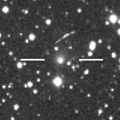
|
Brightened rapidly. Now it is 13.9 mag (June 25, Taras Prystavski). It will brighten up to 13-14 mag and will be observable in excellent condition from spring to summer in the Southern Hemisphere. It locates low in the Northern Hemispehre.
Date(TT) R.A. (2000) Decl. Delta r Elong. m1 Best Time(A, h)
Aug. 2 12 28.92 -15 20.3 2.242 2.013 63 14.8 18:45 (105, 46)
Aug. 9 12 47.33 -15 34.0 2.323 2.040 61 15.0 18:49 (102, 43)
|
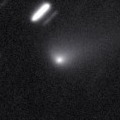
|
It brightened up to 12-13 mag from April to May. Now it is fading. But it is still visible visually at 14.0 mag (July 1, Sandor Szabo).
Date(TT) R.A. (2000) Decl. Delta r Elong. m1 Best Time(A, h)
Aug. 2 14 32.06 -11 45.7 2.436 2.639 89 14.9 18:45 (148, 64)
Aug. 9 14 40.66 -12 25.4 2.532 2.652 85 15.0 18:49 (137, 61)
|
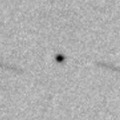
|
Now it is 15.6 mag (July 27, J. F. Hernandez). Getting brighter than originally expected. It is expected to brighten up to 4 mag from autumn to winter in 2015. It is observable in good condition in the Southern Hemisphere until the highlight, or in the Northern Hemisphere after the highlight.
Date(TT) R.A. (2000) Decl. Delta r Elong. m1 Best Time(A, h)
Aug. 2 23 53.43 -16 0.2 5.179 5.947 135 15.2 3:13 (180, 71)
Aug. 9 23 49.42 -16 50.6 5.041 5.882 142 15.1 2:41 (180, 72)
|

|
New bright comet. Now it is 15.4 mag (July 11, Taras Prystavski). It keeps 15 mag for a long time from 2014 to 2015. It is observable in excellent condition in 2014 in the Southern Hemisphere, or in 2015 in the Northern Hemisphere.
Date(TT) R.A. (2000) Decl. Delta r Elong. m1 Best Time(A, h)
Aug. 2 1 54.49 -35 24.1 3.849 4.316 110 15.3 5:13 ( 0, 90)
Aug. 9 1 52.93 -35 35.9 3.752 4.289 115 15.2 4:44 ( 0, 89)
|

|
Big asteroid discovered in 1906. It suddenly showed the cometary activity on Dec. 11, 2010, probably due to an impact of a small object. It has already turned to be stellar.
Date(TT) R.A. (2000) Decl. Delta r Elong. m1 Best Time(A, h)
Aug. 2 4 22.97 16 59.5 3.727 3.385 62 15.3 5:27 (217, 29)
Aug. 9 4 29.57 17 21.5 3.638 3.388 67 15.2 5:21 (214, 30)
|
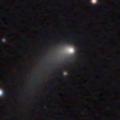
|
Now it is 14.4 mag (June 29, Katsumi Yoshimoto). It keeps 14 mag for a long time until 2014 summer. It keeps observable in good condition in the Northern Hemisphere. It keeps unobservable after this in the Southern Hemisphere.
Date(TT) R.A. (2000) Decl. Delta r Elong. m1 Best Time(A, h)
Aug. 2 12 35.37 49 41.9 2.543 2.134 55 15.3 18:45 (154, -3)
Aug. 9 12 55.41 46 13.8 2.613 2.190 54 15.5 18:49 (150, -1)
|
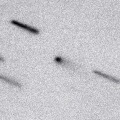
|
Now it is 15.8 mag (July 20, Toshiyuki Takahashi). In the Northern Hemisphere, it will be getting higher gradually after this, and keeps observable in good condition while the comet will be fading gradually. In the Southern Hemisphere, it keeps extremely low.
Date(TT) R.A. (2000) Decl. Delta r Elong. m1 Best Time(A, h)
Aug. 2 5 28.62 24 19.7 2.063 1.552 46 15.5 5:27 (226, 14)
Aug. 9 5 50.15 25 41.8 2.037 1.560 48 15.6 5:21 (225, 13)
|
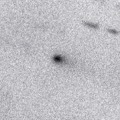
|
Now it is 14.6 mag (July 8, iTelescope Observatory, Siding Spring). It keeps 15-16 mag until August. But it keeps low for a while.
Date(TT) R.A. (2000) Decl. Delta r Elong. m1 Best Time(A, h)
Aug. 2 5 31.23 20 9.7 2.099 1.578 46 15.7 5:27 (229, 17)
Aug. 9 5 50.81 20 11.7 2.089 1.606 48 15.8 5:21 (229, 17)
|
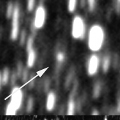
|
Now it is 16.2 mag (June 30, Jean-Francois Viens). Distant object, but it keeps observable at 14 mag for a long time from 2015 to 2016.
Date(TT) R.A. (2000) Decl. Delta r Elong. m1 Best Time(A, h)
Aug. 2 18 58.99 -2 43.1 5.851 6.745 149 16.1 22:15 (180, 58)
Aug. 9 18 57.00 -3 0.3 5.868 6.713 143 16.1 21:45 (180, 58)
|
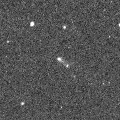
|
Now it is 15.9 mag (July 11, Toshiyuki Takahashi). First return of a new periodic comet which brightened up to 13 mag in 2007. It was expected to brighten up to 13 mag again and observable in good condition from summer to autumn in 2014. But actually, it is fainter than expected. It will be 16 mag at best actually.
Date(TT) R.A. (2000) Decl. Delta r Elong. m1 Best Time(A, h)
Aug. 2 23 46.82 -5 44.1 1.471 2.300 134 16.3 3:06 (180, 61)
Aug. 9 23 48.21 -6 34.0 1.416 2.296 141 16.2 2:40 (180, 61)
|
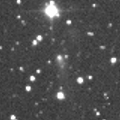
|
It brightened rapidly, and became brighter than originally predicted. Now it is 15.3 mag (June 25, Taras Prystavski). It will be observable at 14-16 mag for a long time from 2013 to 2014.
Date(TT) R.A. (2000) Decl. Delta r Elong. m1 Best Time(A, h)
Aug. 2 15 42.80 -24 48.9 3.895 4.342 109 16.4 19:00 (180, 80)
Aug. 9 15 44.90 -24 53.8 4.011 4.359 103 16.5 18:49 (161, 79)
|
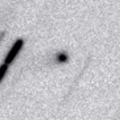
|
Now it is 16.9 mag (July 11, Taras Prystavski). It is expected to brighten up to 14 mag from 2015 to 2016. It is observable in good condition in the Southern Hemisphere. It will be observable also in the Northern Hemisphere after mid August.
Date(TT) R.A. (2000) Decl. Delta r Elong. m1 Best Time(A, h)
Aug. 2 5 34.13 -18 58.7 5.751 5.319 60 16.6 5:27 (265, 42)
Aug. 9 5 35.21 -19 12.5 5.644 5.285 64 16.5 5:21 (261, 46)
|

|
Now it is 16.8 mag (July 28, Hidetaka Sato). It will brighten very rapidly after this. It is expected to be observable at 14.5 mag in excellent condition from October to December.
Date(TT) R.A. (2000) Decl. Delta r Elong. m1 Best Time(A, h)
Aug. 2 3 4.25 7 14.5 1.674 1.862 83 16.9 5:27 (200, 46)
Aug. 9 3 18.64 8 33.2 1.593 1.837 86 16.6 5:21 (197, 45)
|

|
It brightened up to 12-13 mag from 2012 to 2013. Now it is fading. But it is bright as 15.7 mag still now (July 11, Toshiyuki Takahashi). It keeps 16-17 mag until autumn, and will be observable in good condition.
Date(TT) R.A. (2000) Decl. Delta r Elong. m1 Best Time(A, h)
Aug. 2 1 2.16 -13 49.5 3.301 3.894 118 16.6 4:21 (180, 69)
Aug. 9 1 1.99 -14 19.0 3.238 3.912 125 16.6 3:53 (180, 69)
|
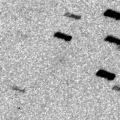
|
It brightened up to 14.5 mag in July (July 7, Michael Jager). Now it is fading rapidly. It will be fainter than 18 mag in August.
Date(TT) R.A. (2000) Decl. Delta r Elong. m1 Best Time(A, h)
Aug. 2 5 51.10 25 17.4 1.374 0.910 41 16.7 5:27 (229, 10)
Aug. 9 6 17.92 25 42.2 1.442 0.970 42 17.3 5:21 (230, 9)
|
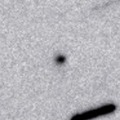
|
Now it is 16.7 mag (July 8, iTelescope Observatory, Siding Spring). It keeps observable at 15-16 mag for a long time from 2015 to 2016. In the Northern Hemisphere, it is observable in excellent condition. It locates somewhat low in the Southern Hemisphere.
Date(TT) R.A. (2000) Decl. Delta r Elong. m1 Best Time(A, h)
Aug. 2 4 5.46 16 14.2 6.426 6.102 67 16.9 5:27 (214, 32)
Aug. 9 4 7.57 16 48.1 6.293 6.075 73 16.8 5:21 (208, 33)
|
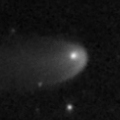
|
Now it is 18.2 mag (July 3, K. Hills). It brightened up to 13 mag from 2011 to 2012. It will be fading after this, but it keeps brighter than 18 mag until 2015 spring. Although it had been low for a while, now it locates high in the morning sky again in the Southern Hemisphere. It will be getting higher also in the Northern Hemisphere after late July.
Date(TT) R.A. (2000) Decl. Delta r Elong. m1 Best Time(A, h)
Aug. 2 3 56.18 -4 27.1 8.783 8.579 75 16.9 5:27 (226, 50)
Aug. 9 3 56.92 -4 25.4 8.714 8.615 81 16.9 5:21 (218, 53)
|

|
Now it is 16.9 mag (July 1, E. Bryssinck). It keeps 17 mag for a long time from 2014 to 2015. It is observable in excellent condition in the Northern Hemisphere. It is observable only until 2014 summer in the Southern Hemisphere.
Date(TT) R.A. (2000) Decl. Delta r Elong. m1 Best Time(A, h)
Aug. 2 15 36.50 34 37.1 3.837 3.961 89 16.9 18:53 (180, 20)
Aug. 9 15 38.59 34 11.7 3.887 3.947 85 16.9 18:49 (175, 21)
|
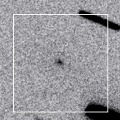
|
Fianlly observed after a 36-year blank since 1978. Now it is 15.6 mag (July 15, Ken-ichi Kadota). It keeps 15-16 mag until July. However, it locates extremely low in the morning sky. It will fade out very rapidly after that, and will be fainter than 18 mag in August.
Date(TT) R.A. (2000) Decl. Delta r Elong. m1 Best Time(A, h)
Aug. 2 6 18.98 24 51.2 1.471 0.868 35 16.9 5:27 (234, 6)
Aug. 9 6 49.56 25 22.5 1.548 0.924 35 17.7 5:21 (235, 4)
|

|
Now it is 17.8 mag (Apr. 26, A. Maury, J.-F. Soulier). It has brightened in outburst up to 14 mag twice, in 2006 January and 2011 May. It will pass the perihelion in 2015. It keeps observable at 17 mag for a long time after this.
Date(TT) R.A. (2000) Decl. Delta r Elong. m1 Best Time(A, h)
Aug. 2 21 7.32 -13 4.7 4.943 5.953 173 17.0 0:27 (180, 68)
Aug. 9 21 4.64 -13 18.9 4.933 5.946 176 16.9 23:53 (180, 68)
|
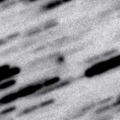
|
Now it is 17.5 mag (June 21, Hidetaka Sato). It will keep 16-17 mag for a long time from 2014 summer to early 2016.
Date(TT) R.A. (2000) Decl. Delta r Elong. m1 Best Time(A, h)
Aug. 2 16 39.23 -24 23.3 2.037 2.717 122 17.1 19:56 (180, 79)
Aug. 9 16 40.25 -24 7.8 2.089 2.689 115 17.0 19:29 (180, 79)
|
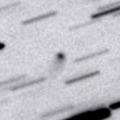
|
Now it is 17.4 mag (June 22, Catalina Sky Survey). It keeps observable at 18 mag for a long time from 2013 to 2016. It keeps locating high in the Northern Hemisphere. It keeps locating very low in the Southern Hemipshere.
Date(TT) R.A. (2000) Decl. Delta r Elong. m1 Best Time(A, h)
Aug. 2 17 17.73 50 30.1 6.251 6.464 97 17.1 20:33 (180, 5)
Aug. 9 17 10.69 50 2.3 6.294 6.463 95 17.1 19:59 (180, 5)
|
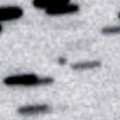
|
Now it is 17.3 mag (June 23, Catalina Sky Survey). It keeps 17-18 mag for a long time from 2014 to 2016.
Date(TT) R.A. (2000) Decl. Delta r Elong. m1 Best Time(A, h)
Aug. 2 13 9.16 -11 5.2 5.728 5.478 70 17.4 18:45 (118, 50)
Aug. 9 13 8.12 -11 19.6 5.836 5.466 63 17.4 18:49 (110, 44)
|

|
First return of a new periodic comet discovered in 2005. It was expected to be observable at 17 mag for a long time from 2013 to 2014. However, it has not been recovered yet. Actually, it is much fainter than predicted, fainter than 20.5 mag (Aug. 1, Jean-Francois Soulier).
Date(TT) R.A. (2000) Decl. Delta r Elong. m1 Best Time(A, h)
Aug. 2 23 7.28 -8 49.9 2.457 3.338 144 17.4 2:27 (180, 64)
Aug. 9 23 4.68 -9 23.8 2.416 3.348 152 17.4 1:57 (180, 64)
|
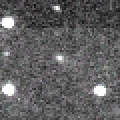
|
Now it is 18.1 mag (July 8, J. Nicolas, A. Klotz, F. Kugel, C. Rinner). It keeps observable at 17-18 mag in good condition from July to October.
Date(TT) R.A. (2000) Decl. Delta r Elong. m1 Best Time(A, h)
Aug. 2 22 22.80 -15 13.4 1.585 2.551 157 17.6 1:42 (180, 70)
Aug. 9 22 19.42 -15 14.0 1.548 2.539 164 17.5 1:12 (180, 70)
|
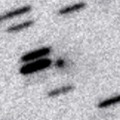
|
Now it is 17.1 mag (June 29, Catalina Sky Survey). It is observable at 17-18 mag from July to August.
Date(TT) R.A. (2000) Decl. Delta r Elong. m1 Best Time(A, h)
Aug. 2 21 12.02 -20 7.1 0.881 1.893 173 17.5 0:32 (180, 75)
Aug. 9 21 11.73 -20 54.0 0.898 1.910 175 17.6 0:04 (180, 76)
|
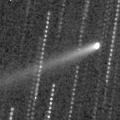
|
It approached to the earth down to 0.06 a.u. in late May, and looked very bright as 11.8 mag (May 29, Marco Goiato). It will be fading very rapidly after this. It has already faded down to 16.7 mag (July 21, K. Hills). In the Southern Hemisphere, it keeps observable for a long time until the comet fades out. It will never be observable again in the Northern Hemisphere.
Date(TT) R.A. (2000) Decl. Delta r Elong. m1 Best Time(A, h)
Aug. 2 18 16.32 -65 53.3 0.678 1.516 125 17.5 21:34 ( 0, 59)
Aug. 9 18 30.29 -63 45.3 0.765 1.579 124 17.8 21:21 ( 0, 61)
|

|
It will brighten up to 14 mag around the perihelion passage in 2019. In 2014, it will be observable in excellent condition at 17 mag from summer to winter in the Northern Hemisphere. It locates extremely low in the Southern Hemisphere. No observations have been reported since February.
Date(TT) R.A. (2000) Decl. Delta r Elong. m1 Best Time(A, h)
Aug. 2 3 26.46 33 12.2 12.962 12.692 72 17.6 5:27 (197, 19)
Aug. 9 3 27.27 33 31.2 12.825 12.664 78 17.6 5:21 (193, 20)
|
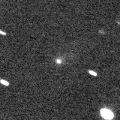
|
It brightened rapidly, and reached up to 15.7 mag (Apr. 22, Taras Prystavski). It is fading since June. It has already faded down to 17.8 mag (July 3, K. Hills). It will be fainter than 18 mag in August.
Date(TT) R.A. (2000) Decl. Delta r Elong. m1 Best Time(A, h)
Aug. 2 14 28.02 -24 58.3 1.907 2.210 93 17.6 18:45 (123, 74)
Aug. 9 14 38.15 -26 0.5 1.994 2.223 89 17.7 18:49 (111, 70)
|
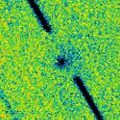
|
Now it is 17.8 mag (July 7, iTelescope Observatory, Siding Spring). In the Southern Hemisphere, it is observable at 18 mag in good condition from July to August.
Date(TT) R.A. (2000) Decl. Delta r Elong. m1 Best Time(A, h)
Aug. 2 20 37.40 -56 10.2 1.428 2.312 141 17.9 23:49 ( 0, 68)
Aug. 9 19 43.43 -59 52.2 1.469 2.285 133 17.9 22:28 ( 0, 65)
|
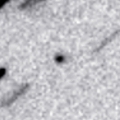
|
It was observed at 17.5 mag in early 2013. It was predicted to be observable at 17.5 mag again from spring to summer in 2014. But actually, it is 20.6 mag (June 21, Hidetaka Sato), much fainter than predicted by 3 mag.
Date(TT) R.A. (2000) Decl. Delta r Elong. m1 Best Time(A, h)
Aug. 2 19 11.03 -17 15.0 2.097 3.057 157 21.2 22:27 (180, 72)
Aug. 9 19 8.04 -17 51.1 2.161 3.080 149 21.4 21:56 (180, 73)
|
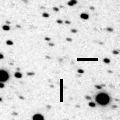
|
It was discovered in 1819, and re-discovered in 2003. Although it was predicted to be extremely faint as 26 mag, it unusually brightened up to 17.5 mag in outburst in 2013 July (July 6, Hidetaka Sato). However, no observations have been reported since mid July. It will pass the perihelion in 2014 August, and will approach to the sun down to 0.96 a.u. The brightness is predicted to be 23 mag at best. However, if the cometary activity continues, it may be observed brighter. Ken-ichi Kadota reported it was not detected, fainter than 16.3 mag, on May 21.
Date(TT) R.A. (2000) Decl. Delta r Elong. m1 Best Time(A, h)
Aug. 2 5 46.29 21 46.0 1.516 1.032 42 22.5 5:27 (231, 13)
Aug. 9 6 22.37 22 17.7 1.513 1.000 40 22.6 5:21 (233, 11)
|
|
![]()
 C/2013 UQ4 ( Catalina )
C/2013 UQ4 ( Catalina ) 4P/Faye
4P/Faye 117P/Helin-Roman-Alu 1
117P/Helin-Roman-Alu 1 29P/Schwassmann-Wachmann 1
29P/Schwassmann-Wachmann 1 32P/Comas Sola
32P/Comas Sola C/2013 R1 ( Lovejoy )
C/2013 R1 ( Lovejoy ) C/2010 S1 ( LINEAR )
C/2010 S1 ( LINEAR ) 17P/Holmes
17P/Holmes P/2014 L2 ( NEOWISE )
P/2014 L2 ( NEOWISE ) C/2011 J2 ( LINEAR )
C/2011 J2 ( LINEAR ) C/2006 S3 ( LONEOS )
C/2006 S3 ( LONEOS ) C/2012 F3 ( PanSTARRS )
C/2012 F3 ( PanSTARRS ) C/2013 Y2 ( PanSTARRS )
C/2013 Y2 ( PanSTARRS ) 134P/Kowal-Vavrova
134P/Kowal-Vavrova C/2013 US10 ( Catalina )
C/2013 US10 ( Catalina ) C/2014 N3 ( NEOWISE )
C/2014 N3 ( NEOWISE ) (596) Scheila
(596) Scheila C/2013 V1 ( Boattini )
C/2013 V1 ( Boattini ) 106P/Schuster
106P/Schuster 16P/Brooks 2
16P/Brooks 2 C/2011 KP36 ( Spacewatch )
C/2011 KP36 ( Spacewatch ) 284P/2013 J1 ( McNaught )
284P/2013 J1 ( McNaught ) P/2012 B1 ( PanSTARRS )
P/2012 B1 ( PanSTARRS ) C/2014 A4 ( SONEAR )
C/2014 A4 ( SONEAR ) 108P/Ciffreo
108P/Ciffreo 246P/2010 V2 ( NEAT )
246P/2010 V2 ( NEAT ) 222P/LINEAR
222P/LINEAR C/2013 V4 ( Catalina )
C/2013 V4 ( Catalina ) C/2009 F4 ( McNaught )
C/2009 F4 ( McNaught ) C/2013 G3 ( PanSTARRS )
C/2013 G3 ( PanSTARRS ) 72P/Denning-Fujikawa
72P/Denning-Fujikawa 174P/(60558) 2000 EC98 ( Echeclus )
174P/(60558) 2000 EC98 ( Echeclus ) 44P/Reinmuth 2
44P/Reinmuth 2 C/2012 K8 ( Lemmon )
C/2012 K8 ( Lemmon ) C/2013 G9 ( Tenagra )
C/2013 G9 ( Tenagra ) P/2005 L1 ( McNaught )
P/2005 L1 ( McNaught ) 303P/2014 L1 ( NEAT )
303P/2014 L1 ( NEAT ) P/2014 L3 ( Hill )
P/2014 L3 ( Hill ) 209P/LINEAR
209P/LINEAR C/2010 U3 ( Boattini )
C/2010 U3 ( Boattini ) P/2014 E1 ( Larson )
P/2014 E1 ( Larson ) C/2014 N2 ( PanSTARRS )
C/2014 N2 ( PanSTARRS ) 280P/2013 C1 ( Larsen )
280P/2013 C1 ( Larsen ) 289P/Blanpain
289P/Blanpain![]()














































